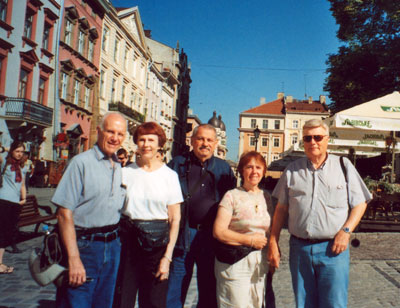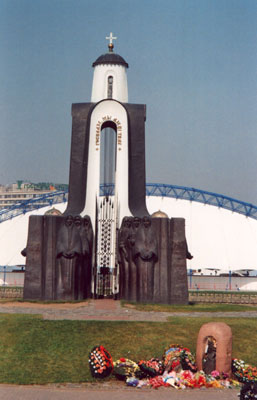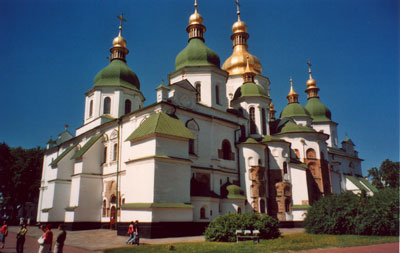Belarus, Ukraine and Moldova: touring three former Soviet republics
by Claus Hirsch, New York, NY
With many world travelers expanding their horizons beyond the popular tourist spots of Western Europe, increased attention is being paid to the former Soviet Republics and now-independent states of the former Yugoslavia.
Those who have been to places like Croatia and Slovenia, for example, know that those countries have many spectacular sights to lure the curious traveler. So, too, is the case with many of the former Soviet Republics, independent states since 1991 that are now trying to build on their long histories to establish new identities.
A tour of three such former Soviet states — Belarus, Ukraine and Moldova — was arranged by MIR Corporation (Seattle, WA; 800/424-7289, www.mircorp.com) for August ’08. MIR Corp. has specialized in travel to the areas in and around Russia for the past 20 years and employs tour leaders who are experienced guides with fluency in Russian and other Slavic languages. Those language skills certainly are useful because virtually everyone in the area above a certain age still speaks Russian.
Beginning in Belarus
Our small group of five travelers started our 2-week tour of Eastern Europe in Minsk, the capital of Belarus. We stayed at the 4-star Minsk Hotel, located across from the post office and one of the ministry buildings.
Our tours in and around Minsk showcased a city with well-paved roads, handsome if massive buildings and a continuing awareness of the suffering the country and its people endured during World War II (which local historians prefer to call the Great Patriotic War). There are museums and numerous monuments that honor the victims, both Jewish and gentile, in addition to some dramatic monuments to the suffering engendered by the country’s war in Afghanistan while it still was a Soviet Republic.
From Minsk, in central Belarus, we took a drive of several hours to reach the town of Brest in the southwest, near the border with Poland. The roads were surprisingly well maintained and surrounded by attractive forests.
In Brest our city tour included a visit to the Brest Fortress, which Czar Nicholas I had built in the 1840s. It was the scene of fierce fighting between Soviet and German armies in 1941 and was lost to the latter after a month of warfare.
Next stop, Ukraine
On the fourth day of our tour, we left Belarus by van and headed for Lviv in Ukraine. Lviv (known as Lemberg in German and Lvov in Russian) has a population of around 800,000 and is the “unofficial capital” of western Ukraine.
Our city tour there included visits to a number of Gothic cathedrals, handsome squares and well-preserved buildings (spanning the 16th to 19th centuries) that had escaped destruction during World War II. The entire Old Town is designated as a UNESCO World Heritage Site.
A visit to Lviv’s oldest pharmacy, dating to 1735, exposed us to many of the curiosities of dispensing medicines nearly three centuries ago.
In Lviv we stayed at the charming 5-star Leopolis Hotel.
We next headed for Kyiv (Kiev in Russian), the capital of Ukraine. Kyiv is an impressive city with many well-preserved churches, cultural institutions, grand monuments and wide boulevards. Much of the infrastructure, of course, was rebuilt after suffering destruction during World War II, but some of the beautiful cathedrals and monasteries date back to the 11th century. We noticed many natives (far more women than men) visiting these religious buildings, often showing their devotion by kissing each icon.
While in Kyiv, we also visited the site of the notorious Babi Yar, a ravine at which 33,771 Jews from Kyiv and its surroundings were massacred by Nazi troops over a 48-hour period in 1941. Several touching monuments commemorate this event and the horrors of the nearby concentration camp of Syrets.
Despite the liquidations of World War II, emigration and natural attrition, Kyiv still has a sizable Jewish population, but only two synagogues remain of the dozens that existed pre-WWII. We visited one of them during our stay.
Yalta
On day nine of our tour, we took a short flight from Kyiv, in central Ukraine, to Simferopol in the southeast, continuing by road to nearby Yalta in the Crimean Mountains. The health resort of Yalta is beautifully located on the Black Sea. It is a very active tourist destination, with many of the visitors coming from Russia. This is a place that is indeed well equipped to handle travelers; some 50,000 rooms are available to house them.
There is a lovely boardwalk that stretches for at least a mile on which, day and night, one sees many families and youngsters parading, taking in all the stores, hawkers and other sights but mostly enjoying the freedom of mingling and relaxing. I thought the boardwalk retained what were probably some of the best aspects of places like Coney Island in the 1920s — clean, colorfully lighted, etc.
In Yalta we stayed at the 4-star Oreanda Hotel, situated right at the entrance to the boardwalk. We veered away from the boardwalk on our second day in Yalta on a walking tour of some of the streets in town, which boast nicely restored 19th- and early-20th-century mansions, some now inhabited by banks and airline offices.
We also visited the ship repair yards in nearby Sevastopol — the former home of the Soviet Black Sea Fleet — where Russians still berth many of their ships alongside Ukrainian vessels.
The highlight of our stay in Yalta, of course, was a visit to the beautiful Livadia Palace in the nearby Black Sea town of Livadia. The palace, built by Czar Nicholas II in 1911, served as the venue for the famous Yalta Conference attended by Roosevelt, Churchill and Stalin in 1945. This building is lovingly maintained, and it was a thrill to see, at close hand, the tables where the world leaders met and dined over 60 years ago.
On to Odessa
Driving from Yalta to Odessa, we took in the lovely trees lining the road, the many farm stands selling watermelons and other produce, and the sight of huge farms with rich, black, freshly plowed Ukrainian soil. I could see what analysts meant when they called Ukraine the breadbasket of the Soviet Union.
Our fourth and final major stop in Ukraine was the coastal city of Odessa on the Black Sea. My first impression was quite negative, as we saw block after block of decaying, Stalin-era apartment houses. Soon, however, there was a magical transformation as we turned off the main road toward the area known as Primorsky Boulevard.
This area houses dozens of beautiful 19th-century mansions — either restored or in the slow process of careful restoration — plus the Duma, or city council building, the grand National Academic Theater of Opera and Ballet and other impressive structures.
We also saw the famous Potemkin Steps (192 of them) leading to the Black Sea. Many of the most beautiful buildings now are owned by banks or casinos.
Our hotel, the Londonskaya, was a 4-star facility with impressive 15-foot ceilings. Located in the midst of the Primorsky area, it was built in 1867 and restored in the 1990s.
Moldova
On day 14 we departed Odessa for Chis¸ina˘u, the capital of Moldova. A short city tour in Chis¸ina˘u included a brief visit to a local convent before we returned to our hotel, the 4-star Leo Grand.
The next day, we visited several Moldovan villages and the huge Miles¸tii Mici Winery for an underground drive through its miles of tunnels and storage facilities. This winery has an inventory of 1.5 million bottles, allegedly making it the largest in the world. We enjoyed a special luncheon and wine tasting in its large tasting room, complete with strolling violinists — quite an experience!
General observations
Our 3-country visit of Eastern Europe was a pleasurable experience, but it reinforced our view that there still are many countries in the world with infrastructure that does not meet Western standards of excellence. Yet there was much to see.
Despite language barriers, we had the chance to visit many historic sites, thanks to our able and considerate tour leader, Irena, and the experienced and engaging local guides who accompanied us outside of Lviv.
Our accommodations, except for our one night in Brest, Ukraine, were excellent. The posted rate at several of the 4- and 5-star hotels at which we stayed averaged about $300 per night.
The food we ate was generally tasty, and I was surprised by the variety of appetizers, entrées and desserts. Breakfasts at each hotel generally consisted of eggs, excellent brown bread, cold cuts, fruit and coffee or tea.
Lunch typically included a simple salad and good fresh soup — mostly borscht or chicken and noodle — and an entrée. Dinners included soup and chicken, red meat or fish plus a dessert of ice cream, cake or pancakes. We were certainly overfed and eventually pleaded for restraint.
Among the Eastern European wines we tasted, those from Georgia were the best, in my opinion.
We did have the opportunity to visit some private homes, including a dacha in the Belarusian countryside and the Lviv apartment of our tour leader. In both places we enjoyed genuine hospitality.
We also had the rich experience of visiting some public markets to see, firsthand, locals buying gorgeous tomatoes, berries and other farm products. And we had the pleasure of seeing several performances by local musicians and dancers in colorful embroidered costumes. In all, it was a memorable tour.
The land-only cost of the 16-day tour, exclusive of single supplements, was $6,295, including all hotels, admissions, transportation within the three countries and nearly all meals.




